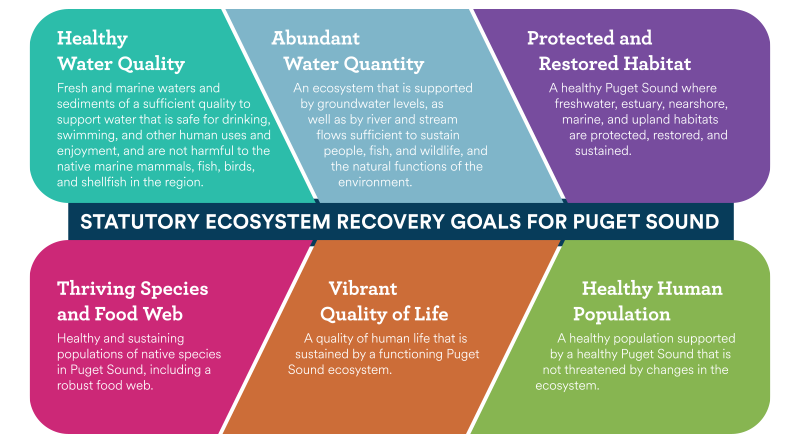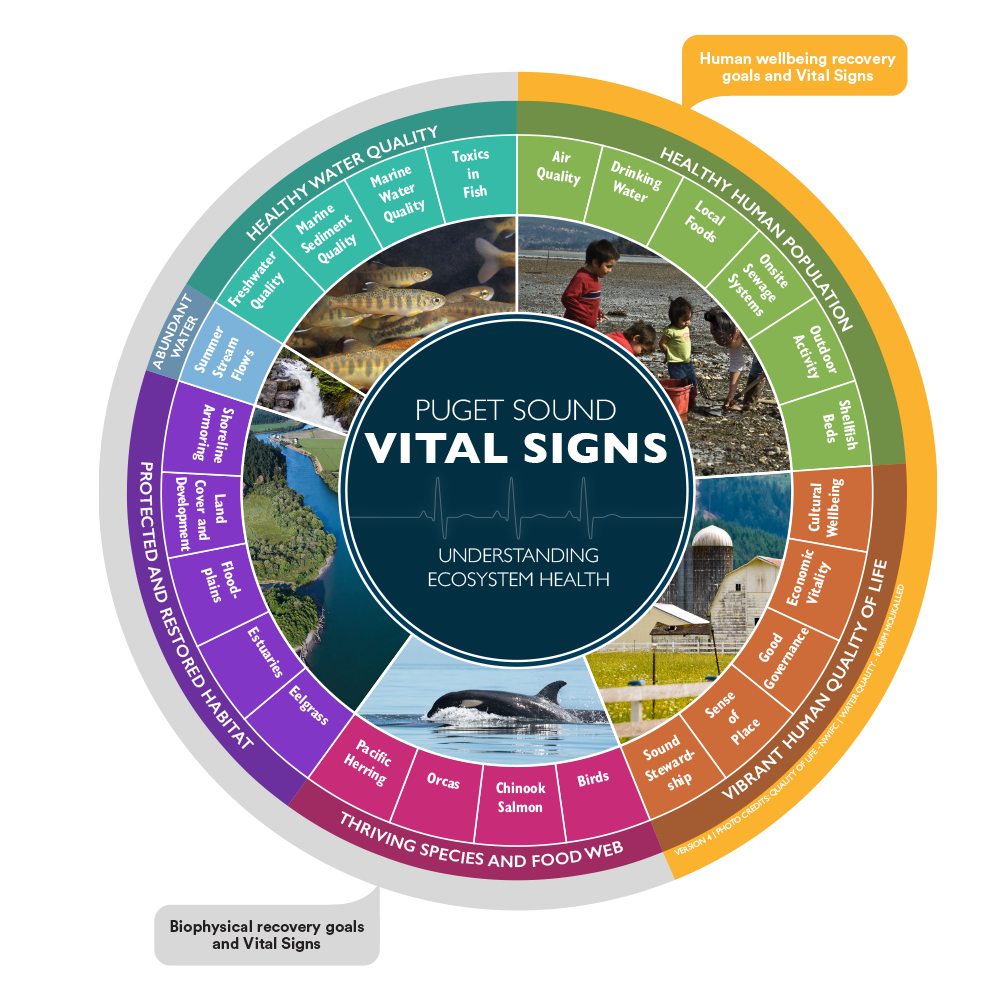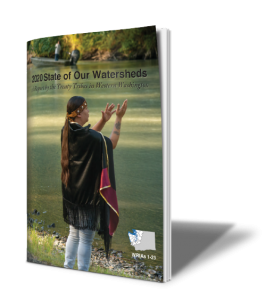How is Puget Sound Doing?
Puget Sound Vital Signs help gauge ecosystem health
The Puget Sound Vital Signs are measures of ecosystem health that guide the assessment of progress toward six statutory Puget Sound recovery goals (figure 1). The Legislature established those goals in statute in 2007. We express each of the six recovery goals with one or more Vital Signs that represent important components of the ecosystem, including human wellbeing (e.g. marine water quality, economic vitality). We use one or more indicators to measure specific aspects of each ecosystem component.
In 2011, the Partnership adopted ecosystem recovery targets (targets), which are science-informed statements of desired future conditions for the indicators. Using the most recent data available, we report here on whether targets set for the year 2020 were achieved. With year 2020 behind us, the Partnership is reviewing the 2020 targets and working with our boards and partners to select new targets over the next few years.

Puget Sound Vital Signs include aspects of human wellbeing
Vital Signs include measures of human wellbeing that illustrate the human or social aspects of ecosystem health in the Puget Sound region. An example of such measures is the number of jobs in natural resource sectors. Thanks to these measures, we include human-related factors in our recovery efforts and recognize the key role of social sciences in providing concepts, methods, theories, and toolkits necessary to understand, address, and integrate human wellbeing into ecosystem recovery.
Knowing about aspects of human quality of life and health help the Puget Sound recovery community make good decisions about how best to sustain healthy ecosystems while also:
Promoting strong communities
Promoting a thriving economy and
Supporting diverse
cultures and ways of life.

Overview of target status and progress of indicators

Puget Sound is not doing well, but we see signs of progress
After more than 10 years of reporting indicators and comparing them to ecosystem recovery targets for 2020, patterns emerge:
- Few indicators reached their 2020 ecosystem recovery targets, signaling that ecosystem conditions are not good enough to say the system is resilient or recovered.
- We see the most progress for the habitat goal. Success arises in areas where decision-makers and land managers have direct influence on habitat outcomes, for example, restoring estuaries and floodplains or preventing conversion of ecologically sensitive lands. Many indicators in the habitat goal measure restoration and land conversion. Where our recovery community is involved, we see progress.
- We see the least progress in indicators affected by multiple factors (such as salmon and orca population abundance) and large-scale forces, such as climate change (which affects marine water quality), and where we rely on decisions made nationally or even globally to create positive change.
- Taken all together, indicators send mixed signals about the health of Puget Sound.
- About half of indicators are either not improving or getting worse.
- Many indicators are not trending in any direction.
- Some indicators show mixed results as conditions may be better or worse, depending on location.
- Most Puget Sound Vital Signs are changing slowly at best.
The recovery community is making a difference. When tribal, federal, state, and local decision-makers work together to protect and restore Puget Sound, the ecosystem improves. However, we must redouble our efforts to ensure the scale of our response matches the scale and urgency of the problem. We need to focus our monitoring efforts to better understand the causes of change, including changes in the health and quality of life of Puget Sound residents.
From mountain peaks to the mouth of Puget Sound rivers to the Pacific Ocean, water connects different parts of the ecosystem. However, the condition of this key resource is at risk for all who depend on it.
Water quality is at risk, but we see notable improvements in places.
- Sediment health at the bottom of Puget Sound shows hopeful signs. An index of exposure to chemicals came within reach of its 2020 target. Also, the number of chemicals found in sediments decreased over the past 20 years in Elliott Bay and Commencement Bay—some of the most urbanized bays in Puget Sound.
- While the health of streams and freshwater quality vary locally, areas less affected by development and that have less impervious surfaces have better water quality.
- Puget Sound water temperatures were generally warmer than normal in recent years but not as warm as during the “2014-2016 blob” of warm water from the Northeast Pacific Ocean. Combined signals from temperature, salinity, oxygen, and nutrients show declining conditions in the marine environment compared to 20 years ago.
- Many contaminants in fish species are a cause for concern, both for the health of species and for the wider food web, including humans, although declines in PBDEs are notable.
We must do more to improve water quality, especially since climate change and an increase in the human footprint will add to the challenges that already exist in the ecosystem. We must restore the health of both marine and freshwaters for the recovery of the whole Puget Sound region. Click here for detailed Healthy Water Quality information.
Puget Sound depends on freshwater that comes from the Olympic and Cascade mountains. Rain, snow, and glacier meltwater recharge our rivers and groundwater. Streamflows vary with the seasons and affect the people, fish, and wildlife that need enough water to survive.
Climate change continues to threaten our water supply.
- The lowest flows, measured in the summertime, have been declining in most rivers since the 1970s. Loss of streamflows in summer months translates into a loss of habitat for fish and is also correlated with lower adult salmon returns.
- The future effects of climate change will worsen the declines in summer low flow, threatening salmon growth and survival.
We must restore natural hydrology and sustain water resources for people, fish, and wildlife by reducing peak flood flows and maintaining or increasing low flows caused by land conversion and development. Click here for detailed Abundant Water Quantity information.
Habitats are our shared natural heritage and create the quality of life that makes Puget Sound an attractive place to live, work, and play. Human activity and development have deeply changed the Puget Sound region.
Conversion of ecologically important lands has slowed, but habitat loss continues throughout Puget Sound ecosystems.
- Humans made habitat gains and improvements through restoration efforts and slowed down the conversion of forests and other ecologically important habitat.
- Preserving habitat is also key for human wellbeing, as it ensures that tribal treaty rights are respected and people have access to land and waters vital for their wellbeing.
- Climate change poses a high risk to most Vital Signs related to the Protected and Restored Habitat goal, with floodplains, estuaries, and shorelines at the greatest risk.
We must counteract the growing human footprint and protect and restore habitat in ways equitable to all, while also making net gains in ecosystem function. Click here for detailed Protected and Restored Habitat information.
A diverse and resilient food web allows for healthy and sustaining populations of native species in the Puget Sound. Healthy habitats, water quality, and the dynamic relationships between species must be restored and preserved to ensure a thriving food web.
None of the indicators for species and food webs have improved. Some species continue to decline while others are maintaining their levels.
- Orca populations, a species in danger of extinction, is only a fraction of what we hoped for by 2020. At last count, there were 74 whales, a mere three-quarters of the 2020 target of 95 whales.
- Puget Sound Chinook salmon, also a threatened species, remain at historic lows and have not experienced significant population changes since they were listed in 1999.
- Marbled murrelets, a threatened species, are declining. Other marine birds, rhinoceros auklets and pigeon guillemots, are maintaining their population abundances.
- Climate change poses a high risk to most Vital Signs related to Thriving Species and Food Web, particularly with orcas, Chinook salmon, and Pacific herring.
We must do more throughout the Puget Sound region to improve native species populations to sustaining levels. Click here for detailed Thriving Species and Food Web information.
A healthy ecosystem provides aesthetic values, opportunities for recreation, and access for the enjoyment of Puget Sound. Tribal cultures depend on the ability to exercise treaty rights to fish, gather plants, and hunt for subsistence, cultural, spiritual, ceremonial, and medicinal needs. Human wellbeing is also tied to economic prosperity.
Humans have complex, reciprocal relationships and interactions with the environment—ones that can contribute to the decline or health of the Puget Sound ecosystem.
- Understanding nature’s influence on people and how we contribute positively to nature allows us to make plans that meet recovery goals for both the ecosystem and people.
- When we consider residents and their wellbeing at all phases of design, planning, and implementation, we improve recovery effort outcomes.
- We now have baseline information about human quality of life in Puget Sound.
- Survey results show that Puget Sound residents have a strong sense of place.
- Survey results show that Puget Sound residents vary in their level of trust in how the environment is managed.
- The region is making progress with overall growth among natural resource industries, largely driven by growth in the recreation and tourism sector.
- Our social sciences work tells us that Puget Sound ecosystem recovery improves the quality of life and connection to the environment for people living in Puget Sound.
We must ensure human wellbeing, in a just, equitable, diverse, and inclusive manner, when protecting and recovering the Puget Sound ecosystem. Click here for detailed Vibrant Quality of Life information.
Humans are part of the Puget Sound ecosystem. From the air we breathe and the water we drink, to the local foods we eat and the parks we enjoy, a healthy Puget Sound supports a healthy human population. However, pollution and unequal access to natural resources degrades the health of Puget Sound residents.
Puget Sound offers foods that grow locally, clean water to drink, and places for recreation, yet many communities face disproportional health risks.
- The Puget Sound region provides an abundance of locally harvestable foods and outdoor opportunities that benefit people’s physical and mental health. Interacting with nature through outdoor activities helps to form and strengthen residents’ sense of place and stewardship of the environment.
- Air pollution impacts both urban and rural communities and the severity of local and regional wildfires in recent years has exposed all Puget Sound residents to poor air quality. Vulnerable communities are often disproportionately exposed to degraded air quality.
- Some areas, northwestern Whatcom County in particular, have experienced widespread and decades-long nitrate contamination, primarily from fertilizers and manure applied to crops. However, most groundwater in Puget Sound is not contaminated by nitrates.
- The Department of Health must limit shellfish harvest and swimming in some areas to protect public health. Overall, we see positive to no trends in closures and advisories due to water quality.
- Toxics in fish and pollution in our water limits the amount of seafood we can safely eat. This raises concerns regarding inequitable health impacts on certain communities who rely on local Puget Sound seafood.
- Climate change is negatively impacting – and will continue to negatively impact – all of these factors that are so critical for healthy human populations.
We must continue to support tribal, federal, state, and local efforts to protect and restore farmlands while reducing harmful runoff. We must keep working regionally to prevent wildfires, and support state, national, and global efforts to mitigate climate change. Click here for detailed Healthy Human and Population information.
Our partners help us monitor the ecosystem
It takes many partners, working side by side, to monitor the ecosystem. The ecosystem is complex. No single source of information exists about how the ecosystem is doing. To answer questions about the ecosystem, we use different sources of information from across the Puget Sound recovery community.
Monitoring delivers key information to evaluate Puget Sound recovery
The Puget Sound Ecosystem Monitoring Program, or PSEMP, is a network of experts who organize and communicate scientific information from different parts of the Puget Sound ecosystem.
Scientists and partners serve as the region’s eyes and ears to assess:
- ecosystem status and trends;
- progress toward Puget Sound recovery; and
- the success of recovery actions.
The science and monitoring data produced by the PSEMP network help inform policies, investments, and actions to advance recovery.
PSEMP builds connections among this network of partners from diverse organizations. The program includes topical work groups for a coordinated approach to monitoring, data sharing, and assessment. Collaboration in monitoring helps us find opportunities for action. Together, partners work to protect and enhance Puget Sound now and for future generations.
The Partnership supports PSEMP and its work groups by supplying staff capacity, funding monitoring projects, and promoting connections to ecosystem recovery efforts. The Partnership has awarded state and federal funds for PSEMP projects that improve monitoring efforts in support of Puget Sound recovery. All projects are expected to support the objectives of the PSEMP’s Strategic Plan to increase collaboration, support adaptive management, and improve communication. Under the latest solicitation Monitoring to Accelerate Recovery in 2021, projects should also address cross-cutting principles of integrating biophysical and social sciences, justice, equity, diversity, and inclusion, and climate change.
In 2019-2021, the Partnership funded six projects with the following outcomes: a nearshore restoration summit and proceedings, a dashboard of climate and oceanographic measures, an annual marine water overview, estuary bird habitat models, prioritizing contaminants of emerging concerns, and juvenile salmon monitoring. For more information about these PSEMP projects, please see Puget Sound Partnership – PSEMP products.
Together with partners throughout the PSEMP network, we track more than 50 indicators.
In this chapter, we draw from findings reported in the Vital Sign web module of Puget Sound Info, a collaborative platform for publicly sharing information about Puget Sound recovery accomplishments and progress toward recovery goals. We also incorporate monitoring results published by the topical work groups supported by PSEMP. Finally, we draw from the scientific work and invaluable knowledge of our tribal partners at the Northwest Indian Fisheries Commission and their seminal State of Our Watersheds Report.
Findings in Puget Sound Info represent data and narrative contributed by dozens of people from state and federal agencies, local jurisdictions, tribes, not-for-profit environmental organizations, academia, and consultants. Leads for reporting on indicators contribute data and narrative, while topical work groups in PSEMP review the indicators and synthesize information to produce high-level messaging for each Vital Sign.

 The Northwest Indian Fisheries Commission’s State of Our Watersheds Report delivers important signals
The Northwest Indian Fisheries Commission’s State of Our Watersheds Report delivers important signals
Every four years, the Northwest Indian Fisheries Commission publishes the State of Our Watersheds Report. The report shows trends in environmental conditions and key issues for the treaty tribes in western Washington.
Each tribe provides indicators and special topics that tie to the region’s environmental health. The report focuses on many water, habitat, and species concerns shared by the Puget Sound recovery community.
We include signals about ecosystem conditions from the report for each of the Puget Sound recovery goals below.

